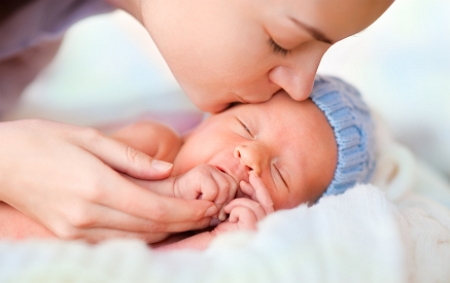Newborn Sleeping

Contents:
- How Much do Newborns Sleep
- Where and How Should Children Sleep?
- Practical Recommendations on the Organization of Sleep in Newborns
- How to Help Your Baby to Sleep Well?
How Much do Newborns Sleep
Newborns sleep from 11 to 18 hours a day, they don’t have any sleep patterns or circadian rhythms. The terms of forming circadian rhythms are genetically determinable and very variable. The ability to distinguish day and night in newborns fully forms only by the 4th month, and by the end of the second month parents start noticing that the baby can tell day from night. During the first few weeks, your baby can sleep from several minutes up to several hours at a time.
However, breastfed children have a shorter sleep duration (2-3 hours) compared to formula fed children. During the first weeks, newborns can’t distinguish day and night. Expect that your baby may have a high motor activity during sleep. During the sleep, all babies make faces, smile, make sucking movements, toss, move their legs, stretch and jerk. These movements are absolutely normal, infants can make different sounds, sight, sob or cry.
Where and How Should Children Sleep?
The baby’s place to sleep. The baby can sleep in any appropriate place selected by the parents. This may be a cradle or a crib, a bed in parents’ room or in a brother’s/sister’s room. Some parents prefer that newborns sleep together with them, but in this case, they should be aware of suffocation risks and take all the necessary measures.
Sleeping on the back. All children should sleep on their backs (especially before 4 months old) in order to prevent the sudden infant death syndrome.
Practical Recommendations on the Organization of Sleep in Newborns

- During day and night sleep put your baby on his/her back.
- A baby should sleep on a tight mattress with a reliable beam construction. The distance between beams shouldn’t exceed 5cm.
- Make sure that your baby’s face is not covered with a blanket or a draw-sheet and remains open during sleep. If you use a blanket, make sure that it only covers the baby’s legs and belly above the chest. You’d better insert the blanket under the mattress.
- Protect your baby from tobacco smoke.
- Avoid overheating and maintain in the baby’s room a temperature comfortable for adults.
How to Help Your Baby to Sleep Well?
Learn to read the signs your baby is making when he/she wants to sleep. Some tired babies behave nervously or cry, others rub their eyes, watch their mom’s face and roll eyes. Your baby will fall asleep faster and easier, if you can tell when he/she is tired.
Try to stick to the schedule, this is especially true for a night's sleep. Though the baby still can’t tell day from night, make him/her sleep more at night rather than at day. For this purpose, limit the lightning at night and try not to play with the baby before he/she is due to go to sleep. During the day, play with the baby and wake him/her for regular meals and games. However, these recommendations apply only to full-term healthy newborns, because preterm infants need an individual schedule and the sleep-wake rhythm in such children takes longer to establish.
Properly respond to the baby’s needs during his/her sleep. Newborns often need to be lulled or fed during their sleep. This rule applies to the first weeks/months of life. However, if your baby is already 3 months old, try to form a mode of day and bedtimes.
Form the bedtime habits. Even a few weeks old baby has bedtime habits based on reflexes. The time before sleep should be calm, select any appropriate activity from the list: bathing, lulling or carrying the baby in the arms. Try to sleep when your baby sleeps. Parents also need sleep. The perfect solution is to ask your relatives to watch the baby while you are sleeping. Nursing moms should have enough sleep.
Contact your doctor if you cannot form a regime for your baby. Children who particularly often display excitement or anxiety may have diseases such as colic, gastric reflux (the entrance of the stomach contents into the esophagus), rickets or iron deficient anemia. Skin diseases followed by itching always violate sleep in newborns. Breathing disorders (especially the particularities of the upper respiratory tract’s anatomy causing low air intake during sleep) require a polysomnography and a special treatment.